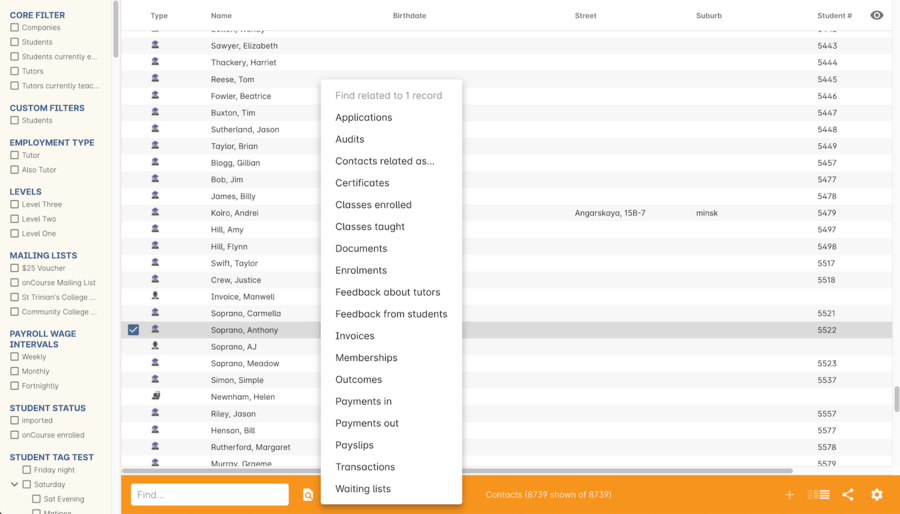Finding contacts
There are multiple ways you can search for contacts in the onCourse database. The simplest method is to type the contact’s name in to the Dashboard search. This will find matching contacts based on the text you have entered. Clicking the results will tatke you to the Contact.
In the contact list view, the filters and tag groups in the left-hand side of the window are also a quick way to find contacts. For example, if you have the core filter 'students currently enrolled' ticked, and select a subject tag, like 'computers' you will see a list of results returned showing all the students who are currently enrolled in a class for a course tagged with a computer tag.
You will see that some tag groups appear multiple times in the window, for example the subject tags (for students enrolled) and the subjects tag (for tutors teaching). You can use these tags on their own, or combination with other filters and queries to create a powerful range of search options.
If you wish to search for contacts based on other criteria, you can do an Advanced Search by typing a query into the search bar at the bottom of the window. These searches require you to type out the query, which can seem difficult at first, but we provide context sensitive search options via a drop down box that appears while you type to help make this much simpler. For more on how to effectively use Advanced Search to build queries, have a read of the Advanced Search section.

Figure 90. Finding contacts with first name "Jim" who are not a tutor using an advanced search query
Creating an advanced search filter
You can save any search query you run in the Advanced Search box by clicking the green bookmark in the right of the search box, then clicking 'Save custom filer'. Give the filter a name and then click the save button to save the filter.
The filter will be available in the same window it was created—i.e. if you create an advanced search in the 'Contacts' window, the filter will only be visible in the Contacts window.
Searching for related information
You can also search for information related to contacts by using the find related records icon which is located to the right of the search field.

Figure 91. The Find Related Records Icon
This option can be useful for finding data related to one of more contact e.g. all the invoices for a company, or all the contacts related to a group of contacts with a particular relationship e.g. all the parents of a group of children.
As you can define the types of contact relationships you wish to collect, this query can be quite powerful. For example, if you know you regularly deliver training to students with additional needs who are supported by agencies, if you have set up this relationship type and made relationship joins between agencies and clients, you can then find all the agents you worked with recently, and send them information about upcoming courses that may interest their clients.
When you run a 'Find related...' search, the results open in a new browser tab, and you can continue to run searches on that returned list of results to further refine your data.
At a glance, for a single contact, be it a tutor, student or company, you can find all their related enrolments, drill down through all their invoices and payments, check the printing or revoked status of each of their certificates or analyse the mailing lists they have subscribed to. For a group of contacts, this search function provides powerful marketing opportunities, and the ability to analyse your student base in a variety of ways.

Figure 92. List of search options available from the "Find related…" icon in the contacts window
Contact insights
If you search for a contact from the global navigation, clicking a contact search result will first open their contact insights panel, instead of the contact record.
You can read up more on this by going to our Contact Insight section in the manual.
Updated over 1 year ago
